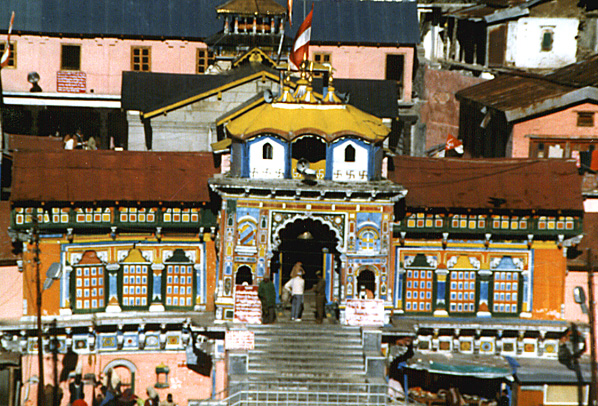- Badrinath temple
Infobox Mandir

creator =Adi Sankaracharya
proper_name =
date_built = 9th century A.D
primary_deity = Badrinarayan (Vishnu )
architecture =
location =Badrinath Badrinath temple, sometimes called Badrinarayan temple, is situated along the
Alaknanda river, in the hill town ofBadrinath inUttarakhand state inIndia . It is widely considered to be one of the holiestHindu temples, and is dedicated toLord Vishnu . The temple and town are one of the fourChar Dham pilgrimage sites. It is also one of the 108Divya Desams , holy shrines for Vaishnavites. The temple is open only six months every year (between the end of April and the beginning of November), due to extreme weather conditions in the Himalayan region.Several
murti s are worshipped in the temple. The most important is a one meter tall statue ofVishnu as Lord Badrinarayan, made of blackSaligram stone. The statue is considered by many Hindus to be one of eight "swayam vyakta keshtras", or self-manifested statues of Vishnu.Sen Gupta, Subhadra, "Badrinath and Kedarnath - The Dhaams in the Himalayas", 2002. ISBN 81-7167-617-0] The murti depicts Vishnu sitting in meditative posture, rather than His far more typical reclining pose. In November each year, when the town of Badrinath is closed, the image is moved to nearbyJyotirmath .Description
, or main shrine area. The walls and pillars of the mandapa are covered with intricate carvings.
The main shrine area houses the black stone image of Lord Badrinarayan, sitting under a gold canopy, under a Badri Tree. There are fifteen more murtis around the temple that are also worshipped. These include murtis of Nara & Narayana,
Narasimha (the fourth incarnation of Vishnu),Lakshmi ,Narada ,Ganesha ,Uddhava ,Kubera ,Garuda (the vehicle of Lord Narayan), andNavadurga . Hard sugar candy, Pongal,Tulsi , and dry fruits are the typical prasad offered at Badrinath temple.The Tapt Kund hot sulphur springs just below the temple are considered to be medicinal—many pilgrims consider it a requirement to bathe in the springs before visiting the temple. The springs have a year-round temperature of 45°C.
Nambudiri Tradition
Although Badrinath is located in the far north of India, the head priest, or Rawal, is traditionally a
Nambudiri Brahmin from the far south of India inKerala . This tradition was begun byAdi Shankara , who was aMalayali . The Rawal is assisted by Dimri Pundits belonging to Village Dimmer ofGarhwal .Badrinath is one of the few temples inNorth India that follow the ancient Tantra-Vidhi ofShrauta tradition more common inSouth India . Devotees of all faiths and all schools of thought of Hinduism visit the place. Many religious heads of various Muths, such as Jeeyar Mutt (Andhra mutt), Sringeri, Kanchi, Udupie Pejavar and Manthralayam Sri Raghavendra Swamy Muths have their branches/guest houses.History
Badrinath was originally established as a pilgrimage site by
Adi Shankara , founder of the Advaitha Philosophy of the Sanatana Dharma (as he referred toHinduism in the ninth century. Shankara discovered the image of Badrinarayan in the Alaknanda River and enshrined it in a cave near the Tapt Kund hot springs.Nautiyal, Govind Prasad, "Call of Badrinath", Shri Badrinath-Kedarnath Temples Committee, 1962.] In the sixteenth century, the king of Garhwal moved the murti to the present temple.The temple has undergone several major renovations, due to age and damage by avalanche.Randhir Prakashan, "The Holy Places of Uttarakhand Yatra".] In the 17th century, the temple was expanded by the kings of Garhwal. After significant damage in the great 1803 Himalayan earthquake, it was rebuilt by the King of Jaipur. [Cite web|url=http://www.boloji.com/environment/62.htm|title=Uttaranchal Developing on Shaky Ground|accessyear=2007|accessmonthday=October 5|publisher=Boloji.com|work=] It is one of the five Punyakshethras (Holy places)where the Hindus offer Shradddhakarmas (oblations) to their 42 line of ancestors (Both from mother's and father's side) (Other four are Kashi, Gaya, Prayaga and Rameswaram). It is believed that once the Shraddha Karma is performed here, the descendants need not perform the yearly ritual.
Legend
Badrinath is mentioned in religious texts as far back as the Vedic period. Some accounts claim that the temple was built on a former Buddhist temple site. [Tyagi, Nutan, "Hill Resorts of U.P. Himalaya: A Geographical Study" (1991). p. 70. ISBN 8185182620.]
One legend explains the reason that Vishnu is shown sitting in
padmasana , rather than reclining. According to the story, Vishnu was chastised by a sage who saw Vishnu's consort Lakshmi massaging his feet. Vishnu went to Badrinath to perform austerity, meditating for a long time in padmasana. To this day, the area around Badrinath attracts yogis who come for meditation and seclusion.Another legend says that
Shiva andParvati were doing tapas in Badrinath.Vishnu came in disguise as a small boy, crying loudly and disturbing them.Parvati asked the reason for his crying and he replied that he wanted Badrinath for meditation.Shiva andParvati found that it was LordNarayan in disguise. They then left Badrinath and moved toKedarnath .According to the Srimad Bhagavatam, "There in Badrikashram the Personality of Godhead (Vishnu), in his incarnation as the sages Nara and Narayana, had been undergoing great penance since time immemorial for the welfare of all living entities."Srimad Bhagavatam 3.4.22] The
Skanda Purana states that “There are several sacred shrines in heaven, on earth, and in hell; but there is no shrine like Badrinath.” The area around Badrinath was also celebrated inPadma Purana as abounding in spiritual treasures.Panch Badri
Wikimedia Foundation. 2010.
